by Editor | Jun 3, 2013 | Food and Wine, New Articles
Article and photos by Josette King
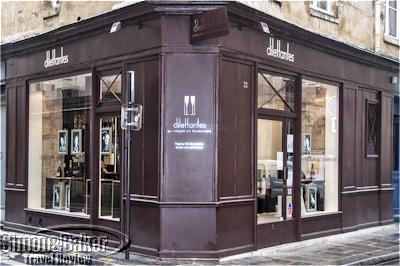
Dilettantes welcomed customers to its elegant corner store front
A far as I can remember, Champagne was synonymous with celebration in my family. From an early age, I understood how exceptional it was: served only on special occasions, in its very own glasses from my mother’s best crystal. And it could only come from the famous region a couple of hours east of Paris that gave it its name. Everything else in thick dark glass bottles with wired corks was just mousseux (bubbly), a word best spoken with a hint of condescendence.
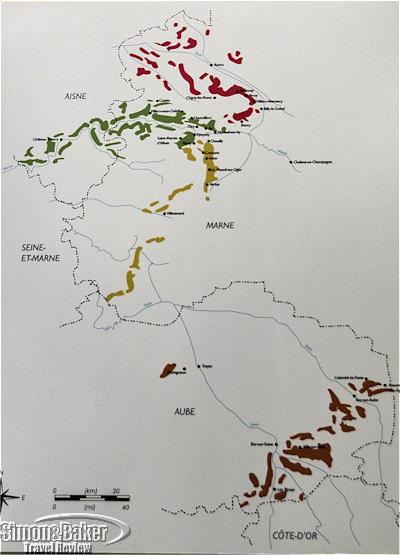
The map of Champagne is a mosaic of small vineyards
Later on, I discovered various major labels of Champagne, and even learned to tell the difference between their offerings. And in my travels around the world, I had many opportunities to experience local sparkling wines that ran the gamut from very nice to best avoided. So I had come to consider myself somewhat knowledgeable about Champagne; until I walked into Dilettantes (22, rue de Savoie, 75006 Paris, France, + 33 (0)1 70 69 98 68, www.dilettantes.fr, champagne@dilettantes.fr), a unique new cave (wine cellar) in the heart of Paris’ historic Left Bank, dedicated exclusively to Champagne.
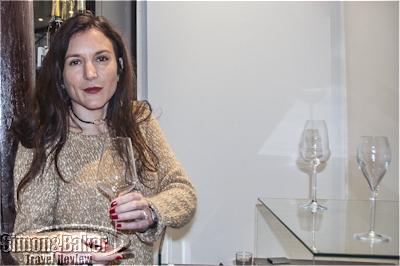
Fanny Heucq introduced me to the various shapes of Champagne flutes for optimal tasting
Located on a side street of the tony 6th Arrondissement, a stone’s throw away from the Seine and the Ile de la Cité, Dilettantes is the brainchild of Fanny Heucq. Born in a family of Champagne vignerons (growers and producers) Fanny knows first hand of the wide variety of high quality Champagnes that are produced in small quantities by artisan growers and rarely available beyond their region of origin. Her goal was to take her Parisian customers past the familiar Grandes Maisons (major world-famous brands) and introduce them to these “other” Champagnes, as diverse as the vineyards and growers that produce them.
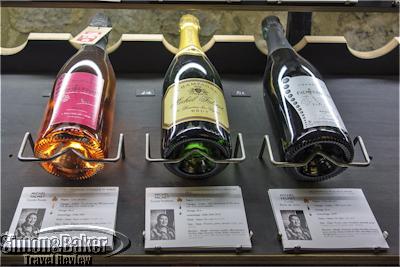
All available labels from the various artisan growers were displayed in the cellar
“I wanted to get beyond the labels to focus on the rich diversity of the crus (vineyards) and the passion of the people who work them,” she explained, nodding at the large black and white photographs that line the windows of her elegant shop. They are the weathered faces and the calloused hands of the vignerons that work the various crus showcased at Dilettantes.
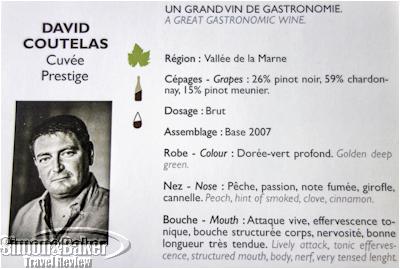
Each bottle was sold with its own identification card
Fanny pointed to a map of the official growing region of Champagne, a mosaic of small vineyards scattered around a 31,598 hectare (122 square mile) area, itself divided into four terroirs (growing areas). “Depending on the soil and the altitude, a different variety of grapes will thrive,” she explained. “In the Montagne de Rheims, it’s 60 percent pinot noir and 40 percent Chardonnay. But to the west, the Vallée de la Marne is just about all pinot noir with barely 10 percent pinot meunier, while a bit to the south, la Côte des Blancs is almost exclusively Chardonnay, and down here,” she pointed due south, “La Côte des Bars is exclusively pinot noir. But the soil is harder here, the microclimates different than around Rheims, so the grapes have a different personality.” Dilettantes featured 25 artisan producers representing the four terroirs, plus a limited selection from a handful of the Grandes Maisons. I was just beginning to grasp the extent of what I never knew I didn’t know about Champagne.
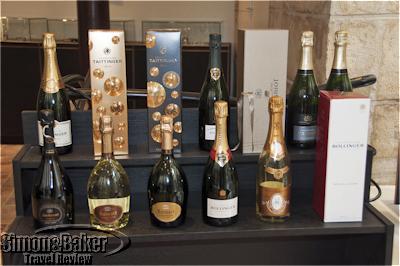
A selection from a handful of world-famous brands was also available
Why Dilettantes? I asked. “Originally, a dilettante meant a passionate amateur, a connoisseur” Fanny pointed out. “Our aim was to create an environment where our customers can discover and appreciate the uniqueness of each cru.” There were many ways to “discover and appreciate” at Dilettantes. First there was the spectacular refrigerated back wall of the street level store. Multiple bottles, 1,000 in all, of the 130 labels from the artisan producers and major brands showcased at Dilettantes were stored there at 10 degrees Celsius (50 degrees Fahrenheit) behind floor to ceiling sliding glass doors. Five meters of wall-to-wall, ready to take home and enjoy Champagne.
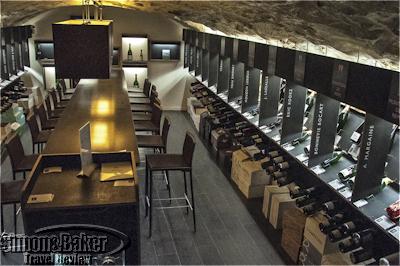
The medieval vaulted cellar was an inviting tasting room
One floor below, the ancient vaulted limestone cellar held an inviting tasting room. Each week, three different labels representing various terroirs were featured for individual on site tasting. Additionally, each month a different grower visited the shop to introduce his or her wines. And there were also occasional thematic tastings (e.g. blancs de noirs, pink Champagnes) lead by Anne Marie Chabbert, an oenologist.
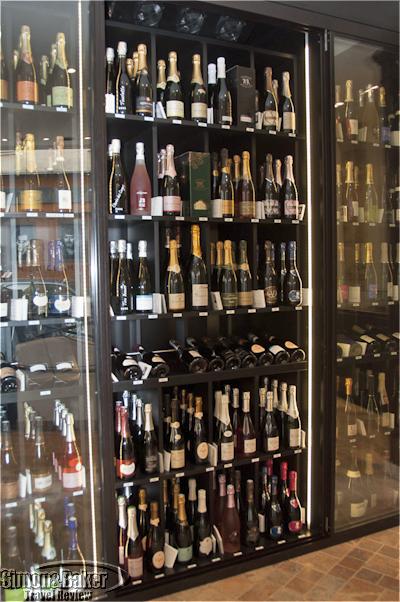
A refrigerated display wall held 1,000 chilled bottles
Whether chilled or at room temperature, enjoyed on site or at home, every bottle was sold with its own pedigree card complete with a picture of the vigneron and salient information regarding the winery, specific vineyard location, grape content, vintage, tasting notes and food pairing suggestions. There was even an entry regarding the type of flute or glass best suited to that particular bottle. I made a mental note to learn more about glasses.
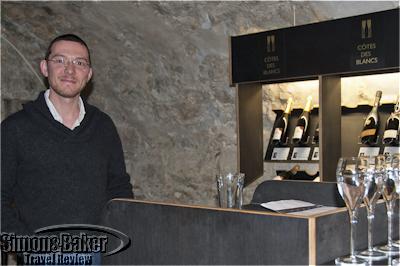
Producer Sébastien Mouzon conducted a tasting of his Champagnes
On my second visit to Dilettantes, Sébastien Mouzon of Mouzon Leroux vineyards, whose family traces back to Verzy (one of the prestigious growing villages of La Montagne de Rheims) since 1780, was on hand to lead a four-wine tasting of his own labels. In addition to an in depth discussion on the particulars of each bottle and what gives it its personality, Sébastien shared a wealth of information on vine cultivation, harvesting and Champagne production. Then came the detail that consolidated the standing of Mouzon Leroux on my personal list of preferred vintners: 70 percent of their production was biodynamic (an ultra-organic wine-making method that focuses on producing naturally fermented wines from organic grapes while healing the vineyard. The biodynamic vintner treats the vines, the soil in which they grow and the surrounding flora and fauna as an interdependent ecological whole).
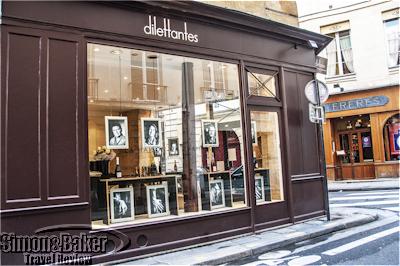
Dilettantes focused on artisan Champagne producers
Warning: Dilettantes is habit forming. I kept finding reasons throughout my stay in Paris to revisit the inviting cave and spent time with its pleasant, knowledgeable staff. I picked up a chilled bottle as a hostess gift on my way to a dinner invitation; I stopped by with a friend for an impromptu tasting of one of the week’s selections; and what about a set of those special tasting flutes, with a couple of well chosen bottles of course, as a housewarming gift for a friend?
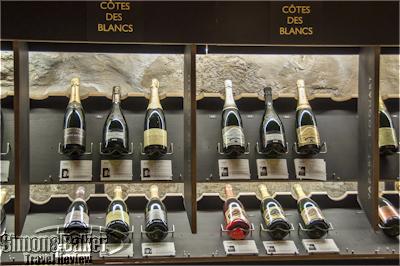
All available labels from the various artisan growers were displayed in the cellar
There is always a good reason to give, and drink, Champagne. And best of all, I enjoyed that on each visit, I left the store with additional nuggets of knowledge about the many facets of Champagne. I already plan to attend one or more of the scheduled tastings on my next visit to Paris. Thanks to Dilettantes’ dedication to making high quality artisan Champagnes readily available in Paris, and educating customers to appreciate them, I may be on my way to becoming a passionate amateur.
by Editor | May 20, 2013 | New Articles, Restaurants
By Elena del Valle
Photos by Gary Cox
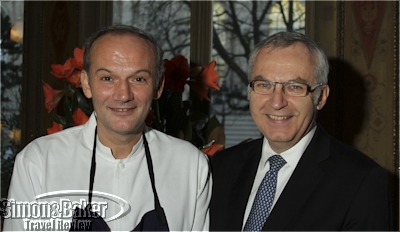
Chef Le Squer and Restaurant Manager Patrick Simiand
Making dining choices in Paris can be challenging. A myriad restaurants await us depending on our culinary preferences and budget. Even in the rarefied top tier of gourmet dining there are many worthy options. For those who take the time to explore unexpected treasures can still be found. Hidden in plain site steps from the famed Champs Elysees is Ledoyen. Even among the city’s culinary giants Christian Le Squer, the restaurant’s reserved executive chef, stands out.
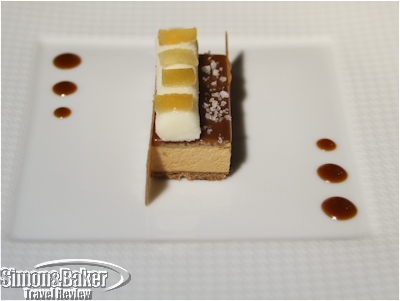
Caramel a la fleur de sel, Givré de Citron
We favor Ledoyen because since our first visit the restaurant has consistently delivered a superb experience. Over the years, the restaurant’s blend of elegance and warmth have made us feel welcome while the cuisine has drawn us back. Although all our meals there have been outstanding, our most recent lunch stands out for its balanced perfection.
by Editor | May 6, 2013 | New Articles, Restaurants
By Elena del Valle
Photos by Gary Cox
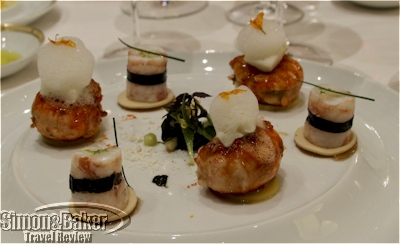
Our amouse bouche at Le Cinq
For more than six years we have been fans of Le Cinq, one of the best known dining venues in Paris, France. The restaurant’s elegant dining room, outstanding service and refined cuisine draw us back regularly.
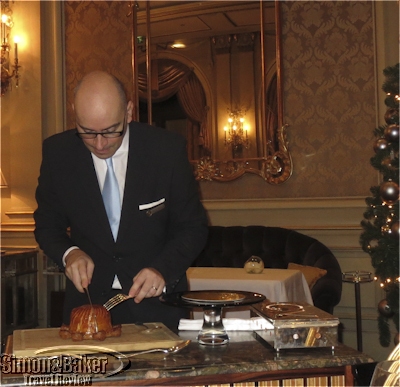
The autumn game pie
On our most recent visit we were rewarded with Chef Eric Briffard’s superlative seafood dishes. We also sampled a seasonal game pie, a specialty only available during a two week window, which was as rich as it was filling.
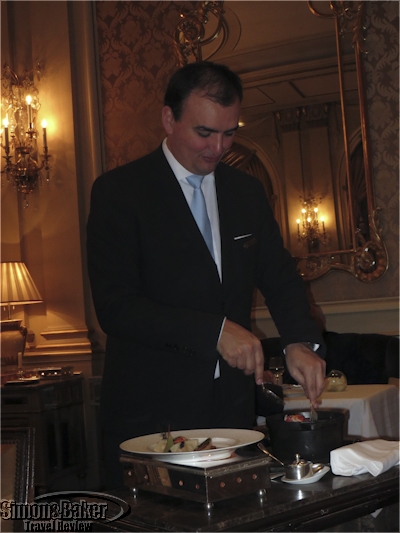
One of the senior staff serving lobster table side from the cooking pot
Friendly, accommodating staff volunteered menu recommendations and assisted us with wine selection. The table side fanfare and partial meal preparation added a special touch to the occasion.
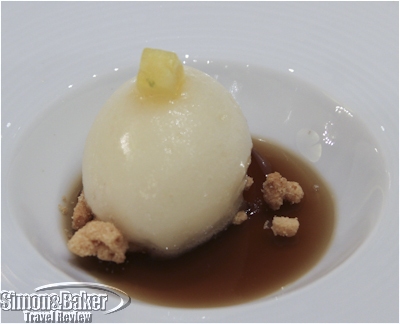
Persimmon sorbet with dates
Our biggest challenge? That by the time the mignardise cart of sweet treats arrived at the conclusion of the meal we had run out of space. The restaurant had a solution for that, a box filled with caramels and nougats for us to take home. We remembered the restaurant and our delicious lunch every time we reached for a piece of candy for the few days that the boxes lasted. It’s those small touches and the memorable meals that bring us back when there are so many fine dining choices in the City of Lights.
by Editor | Apr 22, 2013 | Accomodations, Attractions, Ecotourism, New Articles
Article and photographs by Chester Godsy and Joni Johnson-Godsy
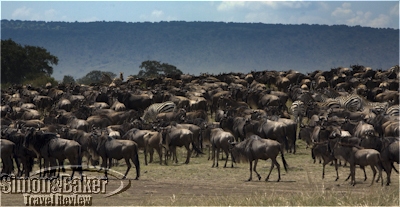
Wildebeest and zebra gathered for the river crossing
Our first visit to Kenya coincided with the well known wildebeest migration. We were delighted to have an opportunity to spend a full day watching the animals gathering on the northern side of the Mara River, preparing to cross into the southern portion of the Maasai Mara Reserve during our stay at Elephant Pepper Camp. Part of the Cheli & Peacock portfolio, the nine-tent 160-hectare property offered a perfect combination of camping luxury in an intimate setting with the backdrop of classic Africa.
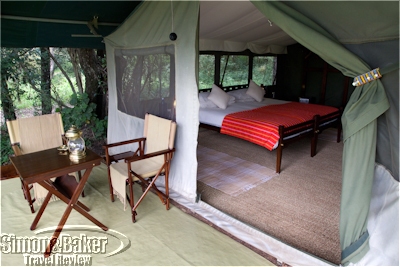
Our tent at Elephant Pepper Camp
by Editor | Apr 1, 2013 | Accomodations, New Articles, Restaurants
Article and photos by Josette King
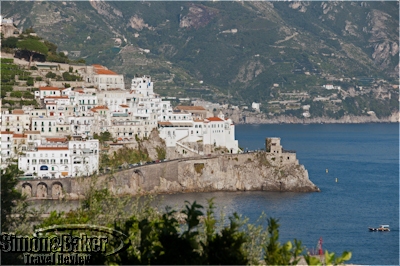
Our terrace had a stunning view of the Amalfi coastline
After decades of saying “some day,” I was finally wending my way along Amalfi Drive. Now officially known as Strada Statale 163, this rapid succession of hairpin turns originally carved by the Romans from the side of towering cliffs rising out of the Tyrrhanian Sea is widely recognized as one of the most spectacular coastal roads in Europe. Each turn revealed more eye-popping scenery. Isolated farmhouses and medieval watchtowers clung to the vertical rock face above, while whitewashed villages tumbled straight down to the sea below. Then on a rare stretch of straight road on the outskirts of Amalfi, an elegant three-story white stone facade appeared at the edge of the cliff. I had arrived at Italy’s version of Eden: the legendary Santa Caterina Hotel.
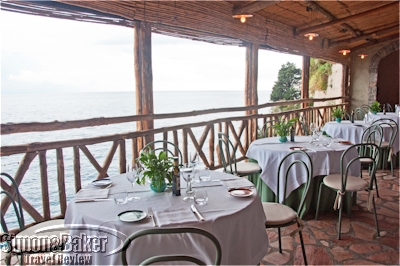
The Al Mare Restaurant terrace
Built into a 60 meters (200 feet) vertical cliff, the century-old property was a sumptuous multi-level complex of terraced citrus groves and lush gardens that started on Almalfi Drive to end with a saltwater swimming pool and private beach at the water’s edge. The hotel had the timeless grace of a classic Mediterranean villa, with light-filled open spaces, vaulted ceilings and arched floor-to-ceiling glass doors opening onto terraces that extended toward the sea. In the common areas as well as in my own suite, pale Majolica tile floors sprinkled with hand-painted flowers, and white walls and ceilings provided an understated background to better showcase the antique furniture and artworks interspersed throughout. But beyond its breathtaking surroundings and exquisite decor, the distinctive charm of the Santa Caterina came from its people, management and staff alike, for whom the property has always been a family affair. Giuseppe Gambardella originally built the villa in 1880, only to see it destroyed by a rock slide a decade later.
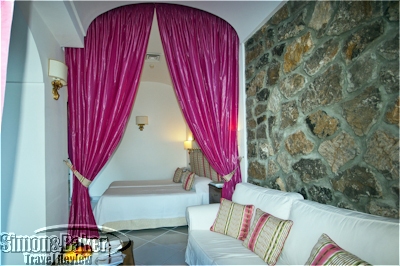
A soaring ceiling enhanced the airy feel of the suite
In 1904, his son Crescenzo personally rebuilt it in a safer location farther up the coast. He included six guest rooms, and the Santa Caterina was born. Fast forward through the 20th century, during which the Gambardella family continuously expanded and enhanced the property to make it the glamorous luxury resort with 66 guest rooms and suites that we enjoy today. Along the way, Crescenzo’s daughters, Giuseppina (Giusi) and Carmella (Ninni) assumed the direction. Now their own children, and more recently grandchildren, hold various positions to carry on the family tradition.
So it is with the staff as well. Many have been at the Santa Caterina for decades, in some cases for two or more generations, an extended part of the Gambardella family, upholding the tradition of flawless service for which the hotel is famous. There is no improvising this unique type of gracious hospitality. It makes me think of the doorman who not only stood with umbrella at the ready, but also profusely apologized for the rain, as though he considered it a personal shortcoming that he had failed to deliver perfect weather every day of my visit.
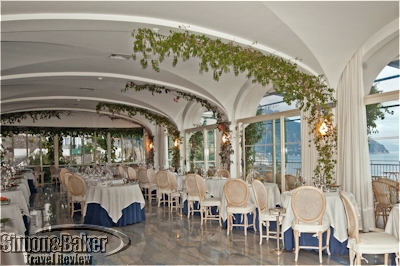
The Santa Caterina Restaurant dining room
The Santa Caterina Restaurant was equally brilliant. Not only did its scenic dining room offer a fabulous view of the old city of Amalfi and the Gulf of Salerno, but it was also one of the best restaurants in town. Whether for lunch or dinner, Chef Domenico Cuomo and his team showcased the excellent traditional cuisine of the area, prepared to order from seasonal ingredients and the latest catch of local fishermen, as well as irresistible home made pasta dishes. There again the service was impeccable: attentive, friendly and precisely paced to ensure a superb dining experience, and a wonderful antidote to the standard tourist fare dished out in abundance all along the coast.
It was a restaurant well worth return visits, even if I didn’t have the good fortune to be a guest at the Santa Caterina; which of course would be most unlikely. Now that I have experienced the unique hospitality of the Gambardella family and staff, I couldn’t imagine staying anywhere else on the Amalfi coast. Rather, I yearn to return to the welcoming embrace of the Santa Caterina as the first opportunity; and yes, it’s nice that the idyllic vistas of the Amalfi coast just happen to be included.
by Editor | Mar 11, 2013 | Accomodations, Attractions, New Articles
Article and photos by Chester Godsy and Joni Johnson-Godsy
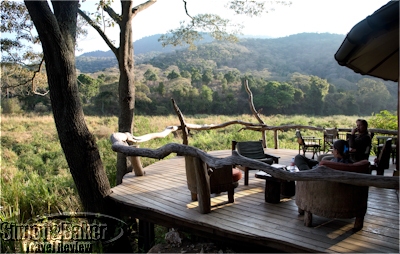
Looking out at the bush from Kitich Camp
In the 1920s, Martin and Osa Johnson traveled from the United States to remote places in Kenya and brought back stories, films and photographs that helped define the American idea of the African safari. Their book entitled I Married Adventure helped peak our curiosity about the mountainous region in Kenya north of Nairobi. It was exciting to imagine that on our trip we were recreating part of their journey nearly one hundred years later.
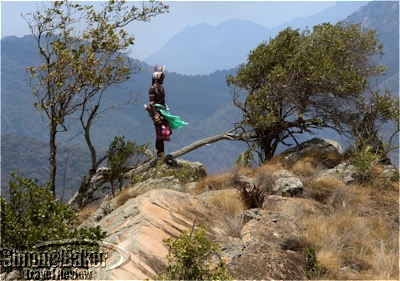
A Samburu warrior in traditional dress
The Samburu people of Northern Kenya live much the way they did back in the days of Martin and Osa Johnson. A Samburu village lies only a couple of miles from Kitich Camp, a walking safari tented camp part of the Cheli & Peacock portfolio, where we stayed on our trip to Kenya. Lamario, one of our guides, took us to this village and helped us bridge the gap between languages and cultures. The Samburu people we met were warm, curious and inviting. Only a few white skinned people had been to the village before us so curiosity was mutual. Visiting this village gave us insights into a time when a community was more important than an individual.
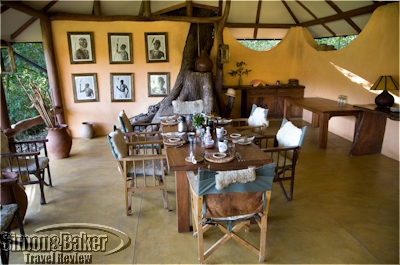
The dining area at Kitich with photos of local Samburu on the walls
A young woman in the village invited us into her home, where we spent time with her and asked her questions about the Samburu lifestyle and culture. We saw the creative ways they live in harsh, arid conditions. We learned about their lives, values and culture. We came away in awe of these people. We had an experience we will treasure for a lifetime.
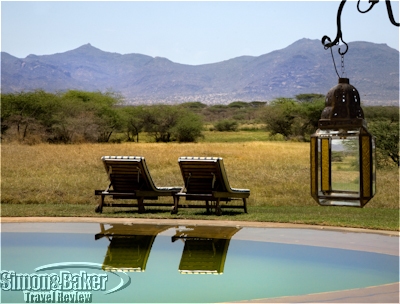
The pool at Joy’s Camp
From there we made our way southeast to Joy’s Camp, its sister property in the Shaba National Reserve still north of Nairobi. Named for Joy Adamson, a well-known naturalist, artist and author, the camp offered comfortable accommodations dramatic views and good wildlife sightings as well as access to the nearby Samburu National Reserve.
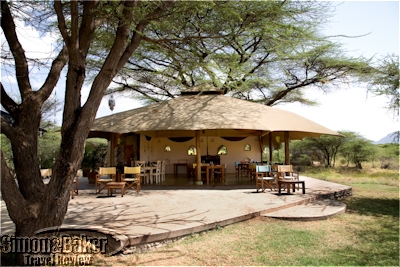
Part of the common areas at Joy’s Camp




































